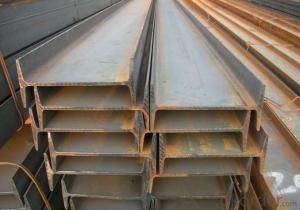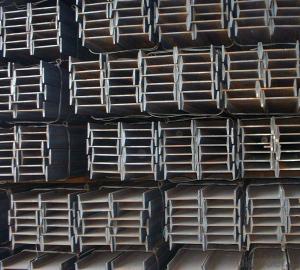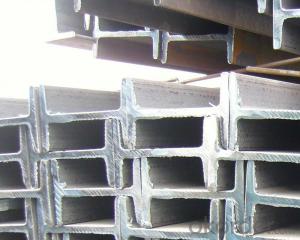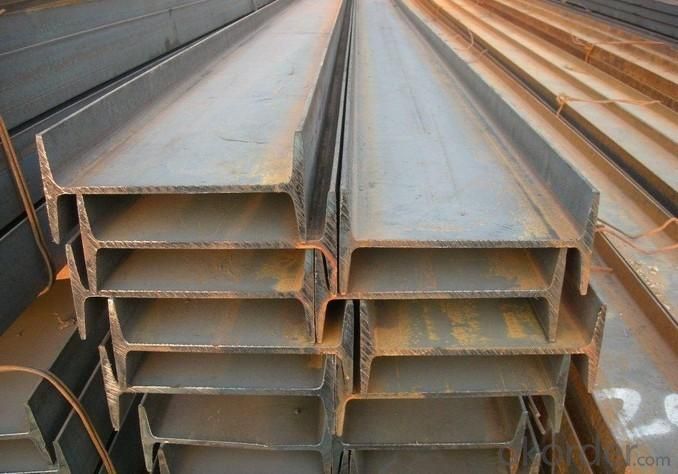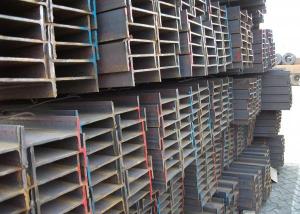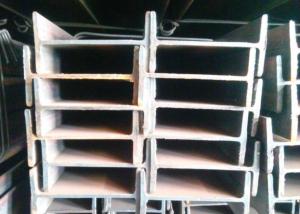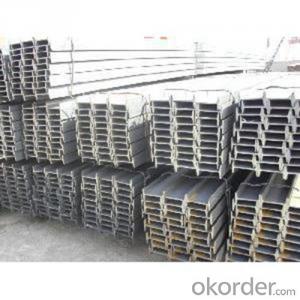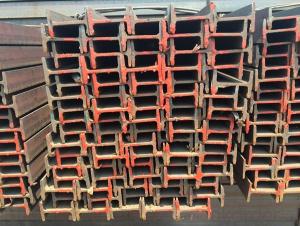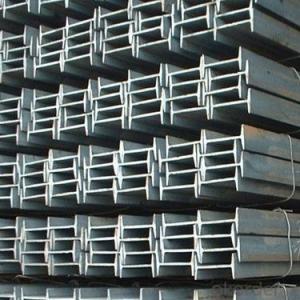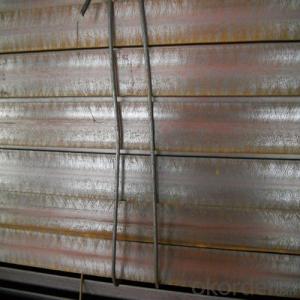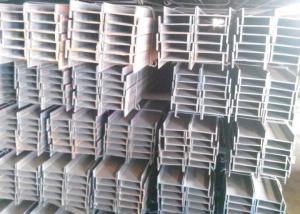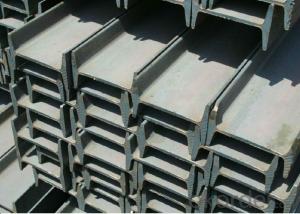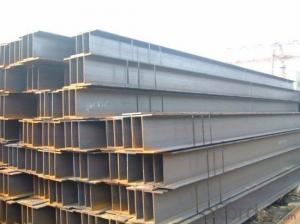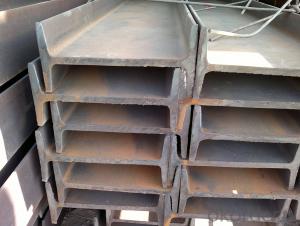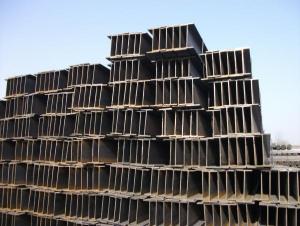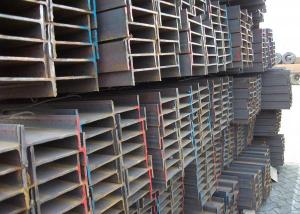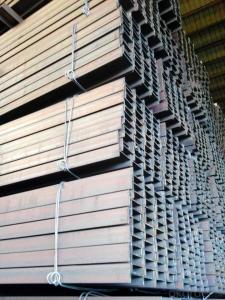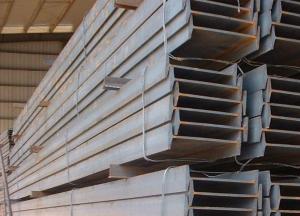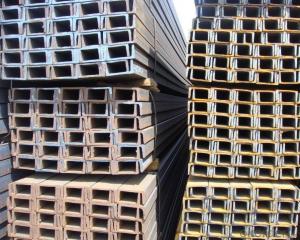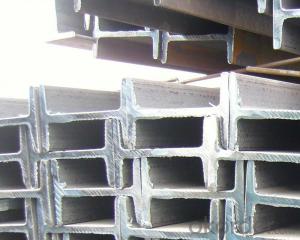Hot rolled H-section steel
- Loading Port:
- China Main Port
- Payment Terms:
- TT OR LC
- Min Order Qty:
- -
- Supply Capability:
- -
OKorder Service Pledge
OKorder Financial Service
You Might Also Like
I-steel beam (also known as English name I Beam), is the section shape of strip steel i-beam.I-steel divides ordinary I-beam and light I-beam, H type steel three. Is the type of groove shaped steel section shape.
Introduction
I-steel beam (also known as English name I Beam), is an H-shaped steel section. I-steeldivides ordinary I-beam and light I-beam, H type steel three. The I-shaped steel is widely used in various building structures, bridges, vehicles, bracket, machinery etc..
I-beam
The reason of ordinary I-beam wing root and light I-beam to the edge of the progressively thinner, has a certain angle, the ordinary I-beam and light I-beam model is the Arabia digitalwith the waist high cm number to represent, web, flange thickness and width of flange to the different specifications to waist high (H) x width (leg b) * waist thickness (d) without number representation, such as "general 160 x 88 x 6", namely said waist high of 160 mm 88 mm in width, legs, waist thickness of 6 mm is ordinary i-beam. / "light 160 x 81 x 5", namely said waistheight 160 mm, width of 81 mm legs, light I-beam waist thickness is 5 mm. Ordinary I-beamspecifications are available models said, type representation of waist high cm, such asgeneral 16#. Waist high same I-steel, if there are several different wide legs and waist thick,need to add a B C to be the difference in the types of the right, such as general 32#a, 32#b,32#c etc.. Hot rolled ordinary I-beam specifications for 10-63#. Hot rolled ordinary I-beamspecifications of both sides of supply and demand supply for 12-55# protocol.
Ordinary steel
The basic difference
I-beam are divided into ordinary I-beam, light I-beam and H type steel three.
Ordinary I-beam, light I-beam flanges on the web is variable cross section of thick, outer thin;H type steel: HW HM HN HEA HEB flange HEM I-beam is uniform
Ordinary I-beam, light I-beam has formed the national standard, the common 10# I-beamequivalent to the international I100 (such as the 10# channel also equivalent to channel(U100) for countries to implement different standards, resulting in subtle differences in their specifications)
H sections are also called the wide flange steel, HW HM HN derived from the European standard, HEB is the German standard I-beam, where HW, HN I-steel has been widely used in our country and production. HEA HEB HEM seen in many German design will, in the domestic market is also very difficult to buy. In the domestic steel structure engineering, if less, you can use the other specifications of steel plate welding assembled. And a large quantity of words,usually consider the use of mechanical properties and equivalent HW, HN type steel instead of.
HW I-beam is mainly used for reinforced concrete frame column steel column, also known asreinforced steel column; in the steel structure is mainly used for the column
HM type steel height and width of flange is roughly 1.33~~1.75 used for steel frame columnsin frame structure under dynamic load is used for the main frame beam in steel structure; for example: equipment platform
HN type steel height and flange width ratio is greater than or equal to 2; mainly used for beam
Use ordinary I-beam equivalent to HN steel;
The I-shaped steel whether ordinary or light, because the section size are relatively high,narrow, so the moment of inertia of the cross-section of two spindle difference, therefore, can only be used directly in the web plane bending component or its component lattice stress components. The axial compression member or in the perpendicular to the web plane and curved components are not used, thus in their application range is limited.
The H steel is efficient and economic cutting surface profile (there are other cold-formed steel, steel etc.), owing to the section shape is reasonable, they can make the steel higher effectiveness, improve the bearing capacity. Different from the ordinary I-shaped flange type H steel was widened, and the internal and external surface is usually parallel, which can facilitate the connection with high strength bolts and other components. Its size to form a series of reasonable, model complete, easy to use design.
The scope of application
Ordinary I-beam, light I-beam, because the section size are relatively high, narrow, so themoment of inertia of the cross-section of two main sleeve difference, thus in their applicationrange is limited. The I-steel should be based on the requirements of design drawings for choice.
The size design
H steel is efficient and economic cutting surface of steel (there are other cold-formed steel,steel etc.), owing to the section shape is reasonable, they can make the steel higher effectiveness, improve load ability. Different from the ordinary I-beam is flange type H steelwas widened, and the inner and the outer surface is usually parallel, which can facilitate theconnection with high strength bolts and other components. The composition of a reasonablesize, model complete, easy to use design.
In structure design, selection of I-beam should be based on its mechanical properties,chemical properties, weldability, structure size and the reasonable choice of the I-beam touse.
Welding process
Flange type H steel are of equal thickness, a rolling section, there are composite section is composed of 3 blocks of plate welding composition. Ordinary I-beam are rolling section,because of the production process is poor, the flange edge 1:10 slope. H type steel rolling is different from ordinary I-beam with only one set of horizontal roll, because of its wide flangeand no inclination (or slope is very small), so it will be a group of vertical roll at the same timerolling, therefore, the rolling technology and equipment than the conventional mill complex.The maximum rolling H steel of domestic production can be the height of 800mm, more thanonly welding composite section.
- Q: Can steel I-beams be used for sports facilities?
- Sports facilities can indeed utilize steel I-beams. The construction industry frequently employs steel I-beams due to their robustness and long-lasting nature. These qualities render them appropriate for bearing significant weights and spanning considerable distances, both of which are often necessary in sports facilities such as stadiums, arenas, and gyms. Steel I-beams can offer the essential support for grandstands, roofs, and other structural components in sports facilities, guaranteeing the structure's stability and safety. Moreover, steel is a versatile material that can be readily tailored and manufactured to meet the specific design prerequisites of sports facilities. Consequently, it remains a favored choice for construction projects of this kind.
- Q: What are the different types of loads that steel I-beams can withstand?
- Steel I-beams are designed to withstand various types of loads, including dead loads, live loads, and lateral loads. Dead loads refer to the weight of the structure itself and any permanent fixtures, such as walls or equipment. Live loads are temporary loads caused by people, furniture, or other movable objects. Lateral loads, also known as wind or seismic loads, refer to forces that act horizontally on the structure. Steel I-beams are engineered to handle these different types of loads to ensure the structural integrity and safety of the building or structure.
- Q: How do steel I-beams perform in earthquake-prone areas?
- Due to their exceptional performance in seismic events, steel I-beams are commonly used as structural elements in areas prone to earthquakes. The inherent properties of steel, such as its high strength and ductility, enable I-beams to withstand the forces and vibrations generated during an earthquake. One of the main advantages of steel I-beams is their capacity to absorb and disperse seismic energy. When an earthquake occurs, the I-beams flex and deform, effectively absorbing the energy produced by ground shaking. This flexibility minimizes damage to the overall structure and reduces the risk of collapse. Additionally, steel I-beams are renowned for their excellent load-carrying capability. With a high strength-to-weight ratio, they can support heavy loads without being excessively bulky or heavy themselves. This characteristic makes them particularly suitable for earthquake-prone regions where structures must endure static and dynamic loads. Moreover, steel I-beams can be designed to possess a high level of ductility, which means they can deform without fracturing. This ductility is crucial during earthquakes as it allows the I-beams to absorb seismic energy through plastic deformation instead of brittle failure. The controlled deformation ability helps prevent sudden structural collapse and provides occupants with valuable time to evacuate the building safely. Furthermore, steel I-beams are often utilized in conjunction with other seismic design measures, such as bracing systems and base isolation techniques. These additional measures further enhance the performance of steel structures in earthquake-prone areas by redirecting and dissipating the seismic forces away from the structure. Overall, steel I-beams have proven to be highly effective in earthquake-prone regions due to their strength, flexibility, and ductility. Their ability to absorb and disperse seismic energy, combined with their load-carrying capacity, makes them a dependable choice for ensuring the safety and resilience of structures during earthquakes.
- Q: How do you transport and store steel I-beams?
- Transporting and storing steel I-beams requires careful planning and adherence to safety guidelines. Here are the steps involved in transporting and storing steel I-beams: 1. Choose the appropriate mode of transportation: Steel I-beams are typically transported by flatbed trucks or trailers. Ensure that the vehicle used is capable of safely carrying the weight and size of the I-beams. 2. Secure the I-beams for transportation: Before loading the I-beams onto the vehicle, ensure that they are properly secured to prevent any movement during transit. Use sturdy straps, chains, or clamps to secure the I-beams to the flatbed, ensuring they are evenly distributed and balanced. 3. Calculate weight restrictions and adhere to regulations: Check the weight restrictions and regulations for transporting goods in your region. Ensure that the total weight of the I-beams, together with the vehicle and any additional equipment, falls within the permissible limits. 4. Arrange for specialized equipment if needed: If the I-beams are too long or heavy to be loaded or unloaded manually, you may need to arrange for specialized equipment such as cranes or forklifts. Ensure that the equipment is suitable for the weight and size of the I-beams. 5. Store I-beams in a controlled environment: If you need to store the I-beams for an extended period, it is important to protect them from environmental factors that could cause corrosion or damage. Store them in a covered, dry area to prevent exposure to rain, snow, or excessive humidity. 6. Properly stack and support the I-beams: When storing I-beams, stack them in a way that ensures stability and prevents any bending or warping. Use wooden or steel pallets to support the I-beams and distribute the weight evenly. 7. Regularly inspect and maintain stored I-beams: Periodically inspect the stored I-beams to ensure they remain in good condition. Check for any signs of corrosion, damage, or deformation. If any issues are detected, take appropriate measures to prevent further deterioration. Remember, it is crucial to follow local regulations and safety guidelines when transporting and storing steel I-beams. Consulting with professionals or experienced individuals in the steel industry can provide valuable insights and guidance for a safe and efficient process.
- Q: How are steel I-beams lifted into place during construction?
- Heavy-duty cranes are typically used to lift steel I-beams into place during construction. These cranes are specifically designed to handle the weight and size of the beams. To begin the process, the crane is positioned near the area where the beam needs to be installed. The beam is then securely attached to the crane using steel cables or chains. Once properly attached, the crane operator lifts the beam off the ground, taking into consideration its weight and balance. The operator controls the crane, maneuvering it into the correct position and then lowering the beam into place. To maintain the structural integrity of the building, it is crucial to ensure that the beam is aligned correctly with other structural components. Signalers or spotters on the ground may assist the crane operator in guiding the positioning of the beam. In some instances, multiple beams may need to be lifted and placed one after the other to form a complete structure. This requires careful coordination between the crane operator and the construction team to prioritize safety and efficiency. Once in its final position, the beam may be further secured using bolts or welds to connect it to other structural elements. These connections are essential for ensuring the overall stability and strength of the structure. Overall, the lifting of steel I-beams during construction demands skilled crane operators and a well-coordinated effort from the construction team. The use of cranes enables precise positioning of the beams, ensuring safe and accurate installation.
- Q: How do steel I-beams perform in areas with high seismic activity?
- Steel I-beams are widely recognized for their excellent performance in areas with high seismic activity. The combination of their structural properties and inherent strength makes them highly suitable for withstanding earthquakes and other seismic events. Firstly, steel I-beams have a high strength-to-weight ratio, which means they can withstand significant loads without being excessively heavy. This characteristic is especially crucial in seismic zones, as it allows structures to be designed with the necessary strength while minimizing their overall weight. The lighter the structure, the lower the seismic forces it will experience during an earthquake. Moreover, steel I-beams possess excellent ductility, which is the ability to deform under stress without losing their overall strength. When subjected to a seismic event, these beams can absorb and dissipate seismic energy through controlled yielding and plastic deformation. This ductile behavior helps prevent catastrophic failure by allowing the structure to flex and absorb the forces generated by the earthquake, effectively reducing the risk of collapse. Additionally, steel has a high tensile strength, meaning it can resist pulling forces. This property is particularly advantageous during seismic events, as it helps the I-beams resist the lateral forces and ground motion generated by earthquakes. Steel's ability to distribute these forces throughout the structure helps minimize localized damage and ensures the overall stability of the building. Furthermore, steel I-beams can be easily reinforced or retrofitted to enhance their performance in high seismic areas. Additional measures, such as the use of diagonal bracing, cross-bracing, or shear walls, can further increase the structural integrity and resilience of the building. In conclusion, steel I-beams perform exceptionally well in areas with high seismic activity. Their strength, ductility, and ability to resist lateral forces make them an ideal choice for seismic-resistant construction. By incorporating steel I-beams into the design of buildings, engineers can enhance the safety and durability of structures in seismic zones, reducing the risk of damage or collapse during earthquakes.
- Q: What is the length of common I-beam?
- The length of the steel bar is generally 9m and 12m; the length of the I-beam and H section steel is generally 12m; the factory length of the angle steel is generally 6 meters; the common length of the channel steel is 6 meters, /8 meters and /9 meters.
- Q: What is the cost of Steel I-Beams?
- The cost of Steel I-Beams can vary depending on factors such as the size, length, and supplier. It is recommended to contact local suppliers or check online platforms to get accurate and up-to-date pricing information.
- Q: Do steel I-beams require regular maintenance?
- Indeed, regular maintenance is necessary for steel I-beams. Similar to any other structural element, steel I-beams are susceptible to wear and tear, as well as potential damage caused by environmental factors. Engaging in regular maintenance ensures the structural integrity of the I-beams and extends their lifespan. Typically, maintenance activities for steel I-beams include visual inspections, cleaning, and repairs. Visual inspections aid in identifying any indications of damage, such as corrosion, cracks, or deformations. Cleaning is crucial to eliminate dirt, debris, and other contaminants that can accelerate corrosion. Repairs may be required to rectify any identified issues, which might involve replacing damaged sections or reinforcing weakened areas. Regular maintenance of steel I-beams is imperative for safety purposes. If left unattended, structural problems can worsen over time, potentially resulting in failures that could compromise the overall stability of a building or structure. By conducting routine maintenance, property owners can address any problems early on and take appropriate measures to prevent further deterioration. It is advised to adhere to the manufacturer's guidelines or consult with a structural engineer to determine the suitable frequency and extent of maintenance needed for steel I-beams in a specific application.
- Q: How do steel I-beams perform in high-wind stadium applications?
- Steel I-beams are commonly used in high-wind stadium applications due to their superior performance in such conditions. The unique design of I-beams, with their flanges providing resistance to bending and the web providing resistance to shear, makes them highly effective in withstanding the forces exerted by strong winds. In high-wind environments, the aerodynamic shape of stadiums can create significant wind loads on the structure. Steel I-beams are able to efficiently distribute these loads, ensuring the stability and integrity of the stadium. The high strength-to-weight ratio of steel allows for the construction of large, open spaces without compromising on structural stability. Moreover, steel I-beams are also highly durable and resistant to corrosion, making them suitable for long-term use in outdoor stadium settings. Their ability to withstand extreme weather conditions, including high winds, ensures the safety of spectators and the longevity of the structure. Additionally, steel I-beams can be easily fabricated and installed, allowing for efficient construction processes in stadium applications. The versatility of steel also allows for customization to meet specific design requirements, ensuring that the stadium can accommodate large crowds while maintaining structural integrity. Overall, steel I-beams are an excellent choice for high-wind stadium applications due to their ability to efficiently distribute wind loads, durability in harsh weather conditions, and ease of fabrication and installation.
Send your message to us
Hot rolled H-section steel
- Loading Port:
- China Main Port
- Payment Terms:
- TT OR LC
- Min Order Qty:
- -
- Supply Capability:
- -
OKorder Service Pledge
OKorder Financial Service
Similar products
Hot products
Hot Searches
Related keywords
